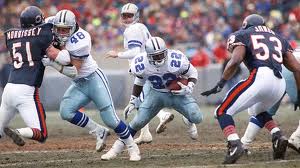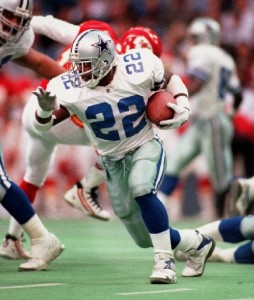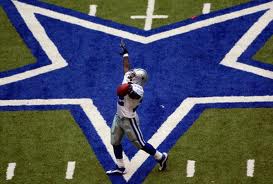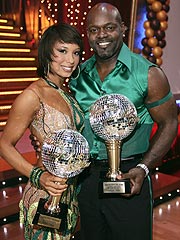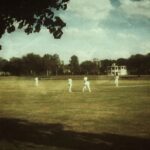Hall-of-Fame Induction is Pinnacle of Legendary Career for Cowboys’ Emmitt Smith
On April 22, 1990 – after the Dallas Cowboys selected him with their first-round pick in the National Football League Draft – Emmitt James Smith III arrived in Dallas for the first time ever as a Cowboy wearing a brown and yellow jump suit with polka dots. Smith, the 17th pick overall, wore the same thing at his introductory press conference. Soon, the legendary running back will be wearing the famous gold jacket.
Can you say extreme makeover? Absolutely. Smith’s attire has not been to shabby since that polka-dotted jump suit. Outfits such as the uniform of America’s Team, striped suit coats at press conferences, and his silky smooth green sleeveless shirt he wore on ABC’s Dancing with the Stars have dotted his wardrobe over the last 20 years. However, the gold jacket is in a class by itself.
In coming full circle, Smith has earned much respect for his on and off-the-field achievements. The National Football League’s all-time leading rusher with 18,355 yards, Smith is on the doorstep of football immortality with only the formal and official festivities left to secure his place in history.
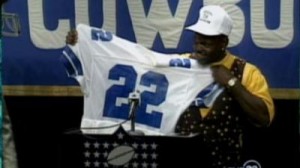
Smith displays his new jersey while decked out in his polka dotted jump suit at his first press conference in Dallas in 1990.
Smith is one of seven players, the maximum allowed in one year, that will be inducted into The Pro Football Hall of Fame in Canton, Ohio on Saturday Aug. 7 in a ceremony starting at 7 pm EST. Smith joins Jerry Rice, John Randle, Rickey Jackson, Russ Grimm, Dick Lebeau, and Floyd Little in making up the Class of 2010. Smith and Rice are both first-ballot inductees while Lebeau and Little were elected as senior committee nominees.
Smith’s journey to football’s ultimate honor started with some bold aspirations. Heading into his rookie year in Dallas, Smith made a list of goals he wanted to achieve during his pro career. Among things like leading the team in rushing and being a pro-bowl player, Smith also stated that he desired to become the NFL’s all-time leading rusher.
Considering he stated this just two weeks after being drafted, before he had signed a contract, before he had ever been in an NFL training camp, and before he had ever touched the ball as a pro, he had his critics. Yet Smith had heard criticism before. NFL head coaches, scouts, personnel directors, and pro football media people did not have him rated as the best running back available heading into the draft. They claimed he lacked speed, was too short, too small, and not strong enough for the pro game.
However Smith would prove the critics wrong in running his way into the record books of the Cowboys and the NFL during a legendary 15-year pro career. Fueling his drive to climb the all-time NFL rushing charts was a belief that heart, toughness, and endurance were traits that no pro football experts could measure. Smith also educated himself about the NFL all-time rushing record and admired the likes of those who held it before him such as Steve Van Buren, Jim Brown, and the late Walter Payton of the Chicago Bears.
Payton, who died from cancer in 1999, had set the NFL rushing record on October 7, 1984 in a 20-7 home win over New Orleans. The record stood for 18 years before Smith broke it. That ended his pursuit of Payton – known as “Sweetness” – who Smith had idolized as a kid.
Smith had old books and videotapes of Payton which he read and viewed as a child. Smith said that he learned about Payton’s training regimen and how Payton ran up the hills along the deltas of the Mississippi River to help condition himself.
Not surprisingly, there are similarities between Smith and Payton in terms of their careers and stature. Payton played 13 years and retired after the 1987 season while Smith played 15 years, playing his last two years for the Arizona Cardinals before retiring after the 2004 season.
Payton was 5-10 and 202 pounds while Smith played at 5-9 and 212 pounds. As they each entered their 13th season, Payton had a career average of 4.4 yards per carry while Smith averaged 4.3 yards per carry.
The similarities did not end there as Payton and Smith were both full of heart and determination. Current Dallas radio announcer Brad Sham was asked to compare the two in “Emmitt Smith Run With History”, a feature program aired by ESPN Classic in 2002 after Smith surpassed Payton’s record.
“The two things you think of when you think of Walter Payton, not some brilliant hip one way, ankle the other way, that’s (Barry) Sanders, that’s (Tony) Dorsett,” recalled Sham, speaking in the film. “Sweetness was a dive into the line of scrimmage and coming through the other side and going six more yards. That was Payton and that’s Emmitt Smith.”
Sham also viewed the all-around game in both as a similar trait.
“The other thing Payton was, was a stone killer as a blocker,” Sham said. “I’ve been doing this in this league 25 years – I haven’t seen a back get that kind of rushing load, block like Payton, except Emmitt Smith.”
Smith was the total package running back in the minds of other media and teammates speaking in “Emmitt Smith Run With History.”
“I think he’s very much like Payton,” said Rick Gosselin, an NFL writer for the Dallas Morning News. “I think he’s a guy that could do it all.”
In stating Smith’s value, Gosselin recalled a game during Smith’s rookie year.
“They were playing the Rams in Los Angeles,” Gosselin said in the film. “He had 100 yards of receiving yards. That told us this is more than a running back. This is a complete football player.”
Fullback Daryl Johnston, who lead the way for so many of Smith’s yards,
echoed this thought.
“To me, when you talk about Emmitt Smith, he is the most complete running back maybe to have ever played the game,” said Johnston, speaking in the film.
Smith’s athleticism allowed him to twist and turn, cut on a dime, and make people miss. Yet Smith was not the fastest and relied on his smarts in many ways. First, he knew that the journey to the record would be a marathon and not a sprint. Chasing Payton would also require that he avoid injury so he wouldn’t miss any games.
Remarkably, heading into the 2002 season – his final one in Dallas – Smith had missed only four games in 12 years due to injury and would go on to play all 16 games that season.
Chasing Payton’s mark would also require stamina, strength, and maintaining a healthy body. Smith met those challenges and more while displaying a warrior-like mentality. He rarely ever took a direct hit which meant he avoided some of the wear and tear on his body. Over his 15-year career that helped him endure father time.
In “Emmitt Smith Run with History”, ESPN Reporter Ed Werder said, “He never came off the field like Barry Sanders did. He was the best first and second down back, he was the best blitz pickup guy, he was the best receiver out of the backfield, the best goal line running back. He’d get hit on every single play at least once.”
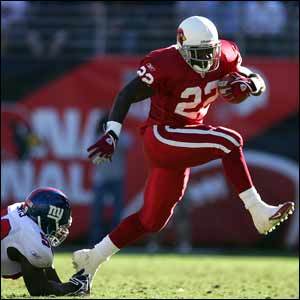
Even by the time he reached Arizona, Smith was still avoiding the New York Giants, a testament to his endurance.
Despite that contact, Smith endured perhaps like no other running back in football history. He logged seven 300-carry seasons which included four campaigns of 360 or more rushing attempts. His relentless toughness and energy symbolized him as one of the best competitors ever to play the game. With the Cowboys featuring him as an every-down back, Smith got the ball more often than the average running back.
“That was quite a responsibility on Emmitt Smith and a lot of wear and tear,” said Jones in an interview segment from “Emmitt Smith Run with History.” “You really had to not only be talented but you had to have a lot of just sheer will and perseverance to take on that kind of load.”
Jones was not kidding. Smith rushed an NFL record 4,409 times, or an average of 294 times per-year during his 15 years. While the Cowboys went through changes in players, coaches, and strategy from 1990 through 2002, the one constant was Smith gaining yards.
Yet those yards didn’t always come easy. Even when he had holes to run through behind dominant Cowboy offensive lines, Smith’s ability to break arm tackles and make people miss allowed him to pile up yards. This was the elusive side to Smith.
“He had an uncanny ability to make people miss,” recalled Dallas quarterback Troy Aikman, speaking in “Emmitt Smith Run With History.”
Smith was also powerful. In more typical Smith-like fashion, he would gain anywhere from five to 10 yards by bouncing off would be tacklers or dragging defenders. Other times he would use his powerful thighs to move a pile on third and short and thus move the chains to keep a drive going.
While Smith avoided a great deal of contact he also did not shy away from it, giving as much out, or more, as he received. Still, many critics thought this might of derailed his career sooner than expected.
That was not to be the case. While running backs in Smith’s era like Detroit’s Barry Sanders, Buffalo’s Thurman Thomas, Minnesota’s Robert Smith, and later Marshall Faulk of the Colts and Rams were faster, Smith approached the game with an extreme amount of determination and desire to be consistent. In fact, Smith couldn’t of said it better himself.
“The hardest thing in the world to do is to have a consistent career and do what you do on a consistent basis for a long period of time,” said Smith, speaking in “Emmitt Smith Run with History.” “To me, that’s what defines a true player.” In proving this, Smith adapted well to changes in key blockers such as his fullback, offensive linemen, and tight end during his 13 years in Dallas.
After rushing for a career high 1,773 yards in 1995, his sixth as a pro, Smith had 8,956 career rushing yards. That left him 7,771 yards short of breaking Payton’s record. Smith was 26 at the time and although he was in his prime he would persevere with a strong work ethic.
During his first six years Smith played on what many pro football experts thought was one of the best teams in NFL history. Lead by hall-of-fame quarterback Troy Aikman, Dallas was loaded. Playmaking teammates like wide receivers Michael Irvin, Alvin Harper, Kevin Williams, and Kelvin Martin combined with tight end Jay Novacek and fullback Daryl Johnston to give Dallas a balanced offense which kept defenses honest.
Inducted into the Pro Football Hall of Fame in 2007, Irvin was a five-time pro bowler and is in the Cowboys’ Ring of Honor. Johnston, a two-time Pro Bowler, was a punishing lead blocker for nearly 10 of Smith’s 13 years in Dallas while Novacek was a reliable pass catcher as a five-time Pro-Bowl pick.
Like these skill players, Smith was also aided by a superior offensive line – considered to be among the best ever by football experts – during the first half of his career. Offensive tackles Erik Williams, the late Mark Tuinei, Kevin Gogan, guards Nate Newton, John Gesek, Derek Kennard, Larry Allen, and center’s Mark Stepnoski and Ray Donaldson opened up huge holes during Smith’s early and prime years.
Allen, a member of the NFL’s all-decade team of the 1990’s, was a pro bowl pick seven of his first eight years in Dallas including six straight as the starting choice at guard or tackle. Allen’s seven trips are the most ever by an offensive lineman in team history. Williams, Tuinei, Stepnoski, Newton, and Donaldson all made the pro bowl multiple times as Cowboys.
While guys like Allen, Johnston, Tuinei, Williams, and Newton remained on the team through the late 1990’s, Smith’s rushing numbers would drop. After posting his fifth straight 1,400 yard season in 1995 to go along with an NFL record 25 touchdowns on the ground (since passed), Smith ran for only 1,204 yards in 1996 and scored less than half as many touchdowns on the ground, 12, as he had the previous year. In 1997, Smith ran for just 1,074 yards, the fewest since his rookie year, and scored only four touchdowns.
The critics said Smith had lost a step and the Cowboys reign was over. Not just as a threat to win the Super Bowl but as a contender in the playoffs, their own conference, and even their own division. While Dallas did fall off for a couple years, they didn’t drop off the radar. Smith made sure of it.
After the Cowboys had their string of six straight playoff trips end in 1997, Smith was at a crossroads in his career. Despite dealing with knee, shoulder, and ankle injuries during portions of the 1996 and 1997 seasons, he didn’t miss a game. Needing to become more focused, Smith re-dedicated himself.
Along with eating healthier and taking better care of his body, Smith began more intense off-season workouts. With the help of Johnston, he saw a chiropractor who aligned his body which reduced muscle pulls in his legs. Smith also began receiving massages twice a week during the season. One was done on Mondays to speed up the recovery from Sunday’s game while the other was done on Fridays to help flush out his body and prepare for the upcoming game.
As the 1998 season came along, Smith and the Cowboys were about to enjoy a resurgence. Playing with renewed energy, Smith ran for 1,332 yards and scored 13 touchdowns. It was his most yards and touchdowns since 1995 as Dallas won the NFC East, Smith’s sixth and final division title as a pro.
Smith followed this up in 1999 with another good season, rushing for 1,397 yards and 11 touchdowns as Dallas reached the playoffs for the second straight year. Smith would continue his assault on the NFL rushing record as he ran for 1,203 yards in 2000 and 1,021 yards in 2001.
In these later years, Smith clearly demonstrated his commitment to consistency. He was still churning out 1,000 yard seasons and reaching the end zone as he logged 40 total touchdowns, 36 on the ground, from 1998 through 2001. Even more impressive was the fact that he did it with new teammates.
Irvin was forced to retire after a neck injury in 1999 and Aikman retired after the 2000 season. While Johnston and Allen remained for some of his later years, Smith now was running behind lineman named Clay Shiver at center, Everett McIver at guard, Solomon Page at tackle, and Flozell Adams at tackle. His tight end was guys like Eric Bjornson and David LaFleur while his fullback changed from Johnston to Troy Hambrick who gave way to Robert Thomas. While they were not as dominant of blockers like Smith had before, they were still created holes for Smith.
Smith’s 1,021 rushing yards in 2001 marked his 11th straight 1,000-yard season, an NFL record. The mark is also an NFL record for most 1,000 yard rushing seasons in a career. By the time the 2002 season rolled around, Smith had Payton’s rushing record within sight as he needed only 540 yards to eclipse his childhood hero. Smith could now taste Sweetness.
After running for 447 yards in the first seven games of 2002, Smith needed only 93 yards to eclipse Payton. He would get it and then some the next game. Facing Seattle at home in Texas Stadium on Sunday October 27, 2002, Smith played inspired football that was reminiscent of his past glory days.
Running with a purpose and showcasing his toughness, Smith broke tackles and produced plenty of those leg-churning runs that marked his career. With the Cowboys trailing 14-7 and 9:28 left to play in the fourth quarter, Smith neared his milestone moment.
Needing 10 yards to pass Payton, Dallas faced a second and seven at their own 30-yard line. Smith took the handoff from quarterback Chad Hutchinson and made a quick cut into the left side of the line behind fullback Robert Thomas. Breaking tackles and using a stiff arm on the ground to keep his balance, Smith displayed the toughness that had carried him this far as he squeezed out the final yards of an epic journey with an 11-yard run to reach 16,728 yards, two ahead of Payton.
The style of the run was only appropriate as it was a microcosm of Smith’s career. Tough and relentless with legs churning and strong thighs breaking tackles. Smith couldn’t of scripted it better himself.
Smith finished the 2002 season with 975 yards and five touchdowns. With his contract up following that season, Smith volunteered to be released by the Cowboys so as not to put Jones in the awkward position of cutting him to fit under the league’s salary cap. On February 27, 2003, in a move to address their future, the Cowboys released Smith after his record-breaking season and the all-time leading rusher signed with the Cardinals.
Smith left Dallas with a boatload of honors and franchise rushing records including the team’s single game (237 yards), single season (1,773), and career (17,162) rushing marks. An eight-time Pro Bowl selection, Smith won four rushing titles including three straight from 1991 through 1993. He was a vital part of the team winning three Super Bowls in a four-year span, the first team ever to accomplish that feat. In 2005, he was inducted into the Cowboys’ Ring of Honor at Texas Stadium along with Aikman and Irvin, his longtime teammates.
In 1993, Smith helped Dallas win its’ second straight Super Bowl while garnering league and Super Bowl MVP honors to go along with his rushing title. At the time of his retirement in 2004, Smith was the NFL’s all-time leader in seven statistical rushing categories including touchdowns with 164 and 100-yard games with 78.
Smith ran to similar honors at the University of Florida where he was a two-time All-American for the Gators. Three games into his freshman season in 1987, Smith got his first start at Alabama. He finished with 224 yards on 39 carries for two touchdowns as Florida upset the Crimson Tide 23-14. A new era had emerged with Smith following a productive lineage of Gator rushers such as Neal Anderson, Lorenzo Hampton, John L. Williams, and James Jones. At the time, Smith’s 224 yards set a Florida record which had stood since 1930.
Smith would go on to have unprecedented success as a Gator. He passed 1,000 yards rushing in just his seventh game as a freshman which at the time was the quickest any runner had eclipsed that mark in college football history. Named the 1989 Southeastern Conference Player-of-the-Year, Smith finished his freshman year as the SEC’s leading rusher with 1,341 yards while tallying eight 100-yard games and an impressive 5.9 yards per carry.
After his junior season of 1989, Smith left the Gators to enter the NFL Draft. At the time he left school he was Florida’s all-time leading rusher with 3,928 yards which was one of 58 school records that he set. Smith also ranks first all-time in rushing yards in a season with 1,599 in 1989. He also ranks atop the school charts with 36 touchdowns on the ground and 23 100-yard rushing games.
A Gator in college, Smith was also a Gator in high school at Escambia High in his hometown of Pensacola, FL. Smith led Escambia to a couple of state championship while playing from 1983 through 1986. By the time he graduated from Escambia, he had set a national high school record with 45 100-yard rushing games. This was a sign of his durability.
“He never missed one practice, he was never in any trouble with any of his teachers, and I never heard him swear one time in four years.” said Dwight Thomas, Smith’s high school coach speaking in “Classic Emmitt Smith.”
Smith rushed for 8,804 yards in his high school career and scored 106 touchdowns. Along the way, he helped Escambia win back-to-back state championships as a sophomore and junior. The title his junior year came the first year that Escambia was classified as 4-A, the largest in the state. All this attracted a lot of attention as Smith received recruiting letters from big name schools with football powerhouses such as Nebraska, Clemson, Florida, Florida State, and Auburn. After narrowing his decision to Auburn and Florida, Smith chose Florida where he went on to be a three-time all SEC player.
Smith’s accomplishments at Florida lead him to be inducted into the Gator’s inaugural Ring of Honor class in 2006. In 2007 he was enshrined into the College Football Hall-of-Fame located in South Bend, Ind.
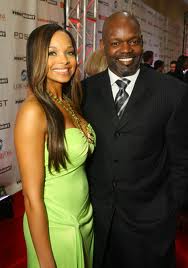
Smith and his wife Pat are involved in many charitable efforts through their work with Pat and Emmitt Smith Charities.
While those accomplishments are significant for Smith the football player, they don’t tell you about Smith the human being. A husband, father, dancer, spokesperson, businessman, and community activist, Smith is already successful in his post-football career which he started during his playing days.
On April 22, 2000, Smith married former Miss Virginia USA beauty queen Patricia Southall. They have a son, Emmitt IV, who was born on Smith’s 33rd birthday, May 15, 2002, and a daughter, Skylar, born in October 2003.
Smith has four enterprises and he took on the role of coordinating them in 1996. They include Emmitt Inc., a collectibles and trading-card company, and Emmitt Smith Communications Corporation which sells and leases cellular phones and pagers. The other two are Emmitt Zone Inc. which licenses his name to companies such as Reebok, Starter, and Scoreboard and Emmitt Smith Charities which handles his philanthropic efforts.
In 2006 he teamed with dancer Cheryl Burke on ABC’s Dancing with the Stars. Using the same grace and elusiveness that characterized his running ability, Smith and Burke won the competition.
An advocate for good will, Smith has worked with children and many organizations. In doing so, he has exhibited charitable acts in support of programs aimed at drug prevention and helping those in need.
In 1986 – as a high school senior – he represented the nation’s prep football players at The White House as part of the “Just Say No” anti-drug campaign. He was the Cowboy’s United way spokesman in 1994-95 and is the founder of Emmitt Smith Charities, a Pensacola, FL based foundation whose mission is to provide educational scholarships to local under-served youth. Smith’s work through his charity has supported organizations such as 100 Black Men of Pensacola, Pensacola Family Care, Boys Clubs of Pensacola, Big Brothers/Big Sisters, The Kidney Foundation, and the Buckner Children’s Home of Texas.
Smith was a Miller Lite NFL Player-of-the-Year finalist in 1991, 1992, 1994, and 1995, and the 1993 winner, donating all money received through the awards to the Sickle Cell Anemia Foundation. In 1997, house majority leader Dick Armey presented Smith with the inaugural Freedom Works Award, which, “recognizes citizens who’s service to their community makes this country a better place.”
Smith also co-founded The Open Doors Foundation, a not-for-profit which supports organizations whose mission is to empower underserved youth to achieve. He has also worked with children through the Make-A-Wish Foundation by hosting many visits with children at the Cowboys’ Valley Ranch practice facility during the season. Smith’s dedication to charity was seen in 2002 when he set the NFL all-time rushing record. Wearing a different jersey each of the four quarters of the game against Seattle, Smith gave one to the Open Doors Foundation. The other three were split up with one each going to Jones, the Pro Football Hall of Fame, and himself.
The 1996 spokesman for the “Texas War on Drugs,” Smith has also hosted an annual “Feed The Children” holiday food drive which supported over 3,000 families in the Dallas/Fort Worth and Pensacola areas. Smith also served as the national spokesman for the Starter/JC Penney “Take A Player to School Program” in which he has made several speaking engagements at schools in Dallas/Forth Worth and Pensacola.
While 2002 saw Smith break Payton’s rushing record, it also saw Smith humbled as he received “The Spirit of Sweetness Award” from the Walter Payton Cancer Fund in July. In his acceptance speech, Smith shed tears while paying tribute to the legendary runner.
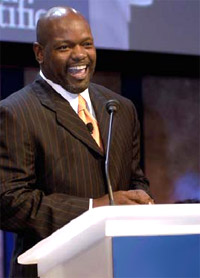
Whether it be to accept awards or help others, Smith has spoken to many schools and organizations to extend good will.
“When you get an award and you do certain things in life and people recognize you for what you’re doing; whether it’s good, bad, or indifferent…(tears),” said Smith in his acceptance speech shown on “Emmitt Smith Run With History.” “But when you get something from a person or a family that represents truly what the game means, a person that was dedicated to excellence, a person that means a lot to me…(tears). I’m trying to be strong, I’m trying to hold my emotions and all, but I just can’t help it,” Smith said. “That’s how much (Payton) meant to me and that’s how much it’s going to mean to me when I break (his record).”
Also in July 2002, Smith was presented the Children’s Medical Center/Athlete Role Model Award from the Dallas All-Sports Association. Earlier that year in June, Smith returned to The White House to be appointed to the President’s Council on Physical Fitness and Sports.
All in all, Smith has come a long ways and done so impressively. Not only in dress or football, but also as a humanitarian.
Credits: The following broadcast, print, and electronic sources were used in the research conducted for this article. ESPN Classic television programming – “Classic Emmitt Smith” and “Emmitt Smith Run with History” (October 2002), Dallas Cowboys media guides (1999, 2000, 2002), Dallas Cowboys Official Weekly (Nov. 2, 2002; Feb. 2005), Dallas Cowboys Star (Feb. 2010), The Pro Football Hall of Fame web site (www.profootballhof.com), the official web site of Emmitt Smith (www.emmittsmith.com), The Emmitt Zone by Steve Delsohn, The Sporting News (Aug. 2002), and The Sporting News (Nov. 4, 2002).


